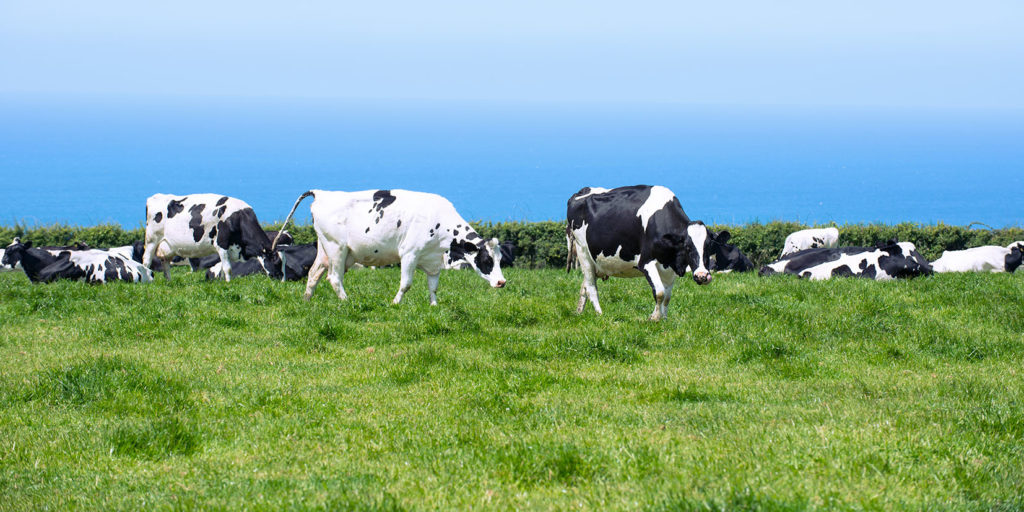Sub-Acute Ruminal Acidosis in the Dairy Herd
24 June 2018Acute acidosis is a metabolic disease characterised by unexplained diarrhoea, inappetence, lethargy, bloating and, in extreme cases, death. It is caused by a sudden drop in rumen pH usually below 5.5, often due to grain/concentrate overload. Sub-acute ruminal acidosis (SARA) is much more common in the dairy herd but the signs are often subtle and can be difficult to detect. A drop in feed intake and consequently reduced milk yield can occur, as well as milk fat depression and changes in cudding behaviour and dung consistency.
A drop in rumen pH occurs when the digestion of rapidly fermentable carbohydrates overwhelms the rumen’s natural buffering capacity, thus creating a more acidic environment. This condition is exacerbated if insufficient and ineffective fibre is present. Providing dairy cows with an adequate amount of effective fibre for good cudding behaviour and saliva production is critical in maintaining appropriate rumen health and function, with the average pH being between 6.5 and 6.8. However, if digestion of large amounts of rapidly fermentable carbohydrates occurs, with insufficient fibre present, then rumen pH can drop and cows will suffer from SARA when rumen pH is around 5 to 5.6. Studies have shown that SARA can affect 20-40% of animals in high producing dairy herds (Calsamiglia, et al., 2012). Grazing cows may also suffer from SARA after eating large feeds of starchy concentrates from parlour feeding and then grazing lush grass.
Cows prone to the condition are those more likely to sort their TMR and favour eating concentrates over forages. Sorting is less likely if feed is well mixed, processed correctly and not too high in dry matter (ideally < 50%). Feeding more than once a day can also help reduce the risk of SARA. Feeding 3 times a day can reduce the length of time spent eating in one period compared with once a day feeding. Smaller, more frequent feeds, helps maintain rumen health, with less fluctuation in pH. Particle size and forage chop length are important, with more finely ground cereals and over processing of forages increasing the risk of SARA. Therefore adopting management changes can help to reduce the incidence of SARA. The diet can also be targeted by using feeds high in digestible fibre to replace some rapidly fermentable cereals, as well as the addition of a rumen buffer or yeast product.
In the US the estimated cost per cow affected with SARA is $1.12 per day or £0.85 ($1 = approximately £0.76 as of 1506/18) (Enemark, 2007). For a 150 milking cow herd with approximately 20% suffering from SARA, this is costing £25.50 per day.
A practical way to assess the presence of SARA is to look at the manure, which is a reflection of nutrition and how well balanced the ration is. When assessing dung, consider the three C’s; colour, consistency and content.
Colour is influenced by forage to concentrate ratio and rate of passage. When cows consume a typical TMR, dung is usually more yellow in colour. This colour results from the combination of grain and forage and will vary according to the amount of grain and processing.
A normal dung pat has a porridge-like consistency and forms a dome-shaped pile 3 to 5cms high (ideally manure score 3 in photo below). Loose dung may be an indication of SARA as high acid production causes this change in consistency. It is important to remember however that diarrhoea may also be caused by poisoning, infection, parasites, or from extensive hindgut fermentation of carbohydrates, excessive protein intake or high levels of rumen degradable protein.
If a large amount of undigested grain or long forage particles are present in dung this is an indication of poor rumen fermentation or an accelerated rate of passage. This may be due to inadequate intake of fibre that is effective in stimulating rumination or maintaining normal rumen pH.
If you think you see a lot of manure like this on your farm as you walk through the cows then it may be SARA affecting some of your herd and it is worth looking into diet or management changes to minimise that loss of £0.85/cow/day.
References
Calsamiglia, S., Blanch, M., Ferret, A. & Moya, D., 2012. Is subacute ruminal acidosis a pH related problem? Causes and tools for its control. Animal Feed Science ad Technology, Volume 172, pp. 42-50.
Enemark, J. M. D., 2007. The monitoring, prevention and treatment of sub-acute ruminal acidosis (SARA): A review. The Veterinary Journal, Volume 176, pp. 32-43.
maimie.sloan@sac.co.uk, 01387 261172
Sign up to the FAS newsletter
Receive updates on news, events and publications from Scotland’s Farm Advisory Service


